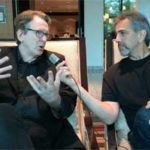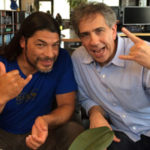Cheap Trick Bassist Opens Up About 12-String Bass, Using Music As Speech Therapy
By David Sands
March 11, 2015
Known for his high-octane 12-string bass playing, Tom Petersson is the man responsible for the riffs lurking in the bedrock of Cheap Trick’s sound.
His galvanic playing laid down a foundation for the band’s emergence as a musical monster in the 1970s, helping them win a fanatical following that’s grown to include luminaries like Gene Simmons, Joey Ramone and Poison’s C.C. DeVille.
A maverick among bassists, Petersson is notorious for pioneering the 12-string bass and wielding his instrument as a second lead guitar for the song “He’s a Whore.” He also recorded the 5-song LP, Tom Petersson and Another Language during a 1980s hiatus from Cheap Trick. Beyond this, he’s appeared on Frank Black’s album, Fast Man Raider Man, Foster and Lloyd’s It’s Already Tomorrow, Donovan’s Shadows of Blue and Coinship’s Godspeed To The General on the song “Valentine.”
FBPO’s Jon Liebman spoke with Petersson recently to find out about his musical origins, equipment and upcoming projects.
While the Cheap Trick bassist’s musical tastes encompass a wide field that includes Miles Davis, Johnny Cash and Weather Report, it’s the British Invasion that kicked off his music career.
As a spellbound 13-year-old, Petersson witnessed the Beatles’ 1964 appearance on the Ed Sullivan Show, an experience he describes in almost religious terms.
“It might have well been aliens dropping down on this earth,” he says. “It was the greatest thing anyone had ever seen—any kid anyway. It just consumed everything that I thought about.”
During his teen years, Petersson found himself swallowed up in an avalanche of British bands, including the Rolling Stones, the Kinks, the Yardbirds, the Bakerloo Blues Line and Yes. Inspired, he began playing rhythm guitar, but eventually realized everyone was playing guitar and that he could get more work as a bassist.
“At that point, bass, it kind of turned into a lead instrument on its own, you know, Paul McCartney and John Entwistle,” he says. “It wasn’t just the standard stuff, boring stuff. You could do whatever. So it really appealed to me.”
Over the years, he’s also found further bass inspiration from Jefferson Airplane’s Jack Casady, Captain Beefheart’s Rockette Morton and Ronnie Wood of the Jeff Beck group.
Growing up in Rockford, Illinois, Petersson became friends with Rick Nielsen, a guitarist making waves in the local scene.
Eventually, they ended up together in a band called the Grim Reapers that opened for English rocker Terry Reid in Chicago. Epic signed them, and they renamed the group Fuse at the label’s request.
Although Fuse’s self-titled LP tanked, Petersson and Nielsen stuck it out. The two relocated to Philly in 1971, briefly playing under the name Sick Man of Europe with future Cheap Trick drummer Bun E. Carlos and Robert “Stewkey” Antoni, a former vocalist and keyboardist with Nazz.
Following a European tour, they returned to Illinois and Nielsen and Carlos launched Cheap Trick with Stu Erickson on bass and Randy “Xeno” Hogan doing vocals. Petersson quickly stepped in as their new bassist, however, and Robin Zander took over as lead singer and rhythm guitarist.
With their classic lineup in place, the band labored in obscurity for several years, playing small gigs in the Midwest. They released three albums that failed to ignite in the U.S., but caught fire in Japan, becoming gold records there.
Touring the Land of the Rising Sun in 1978, Cheap Trick was received with a hysteria that verged on Beatlemania. Recordings from two shows there were used to assemble the live album Cheap Trick at Budokan, which would prove to be their breakout U.S. album and transform the group into international superstars.
They’ve gone on to sell more than 20 million albums, receive 40 gold and platinum recording awards and even write and perform the theme song to Comedy Central’s The Colbert Report.
The bassist himself has had some remarkable highlights of his own too, playing on Bill Lloyd’s Standing on the Shoulders of Giants LP, Edan Everly’s Dead Flowers album and making a cameo in the Ramone’s “Something To Believe In” video. What’s more, he’s enjoyed a steady relationship with Concrete Blonde, appearing on their 1992 album Walking in London, performing a cover of “Buena” with them in a tribute to the group Morphine and playing the song “Someday” together with them on the Dennis Miller Show.
Petersson’s famous 12-string bass came about as a way to extend his band’s musical reach.
“It sounds like a joke, but it’s true. We wanted to add a keyboard player, and the only reason we didn’t was because that would have meant there were five people in the group—and then who would sit in the middle in the car?”
He pitched the idea to Paul Hamer and Jol Dantzig, who were on a trip visiting Nielsen in Philly and planned to start a boutique guitar shop. Skeptical, they went to work on the project. The two finally delivered a prototype, a 10-string, during Cheap Trick’s 1977 tour with KISS.
“I loved it and they loved it,” says Petersson, “so the next one they did was a 12-string. It was a knock off of a Double-Cut Les Paul Jr. By the time we did our third album, Heaven Tonight, I had that thing.”
The 12-string is arranged with three series of EADG strings, each set an octave higher in unison. It doesn’t require any special tuning, though it’s a little slower-moving than a traditional bass.
“It lends itself to my style. It’s more of an orchestrated sound,” says Petersson. “It’s huge, because I use guitar amps and bass amps all at the same time.”
These days, Gretsch makes Petersson’s basses. Right now, he’s playing a prototype of the 12-string White Falcon the company plans to release this summer. It’s done in a double-cut country jam style, and will also appear in a four-string version. It’s strung with D’Addario EXL nickel strings, which the bassist buys in 12-string sets.
While Petersson relies on 12-strings almost exclusively for his live shows, during the recording process he’s also been known to make use of Rivolis, Rickenbackers and Gibson EB-0s.
“In the studio, I use everything,” he says. “Whatever I think a song needs, that’s what I’ll use.”
For amplification needs, Orange is his go-to supplier.
“I love Orange,” he says. “I just love the sound of it. And what’s great about it is it’s a worldwide company, so you can get that stuff anywhere. You don’t have to ship your own gear, which is really prohibitive cost-wise.”
Cheap Trick is waist-deep in creating a new album right now, but that hasn’t stopped Petersson from working with his wife Alison on a side project that’s very dear to them.
Their young son, Liam, is autistic. In order to help connect with him, Petersson began creating simple music geared to people with autistic spectrum disorder. It’s had such a positive impact on Liam that the couple has recorded an entire album’s worth of material and set up a website called “Rock Your Speech” to share the work with other people.
“I want to raise awareness and really get it out there that we live with this. One in 68 kids are now diagnosed with autism,” Petersson says. “For someone with a special needs kid, it’s so huge. They just respond to music immediately.”
He and his wife intend for it to be an ongoing project.
“It’s not kiddie music. It’s the kind of thing anybody should be able to relate to and enjoy,” he says. ”I love making music and recording anyway, so it’s completely natural.”








Great interview David.
Thanks William! Jon actually did the interview and I turned it into a feature. It was really a blast to write!